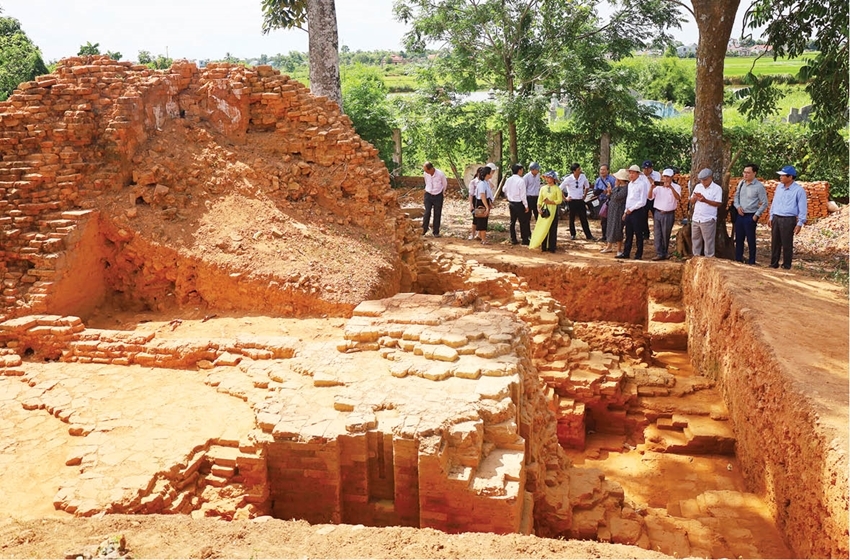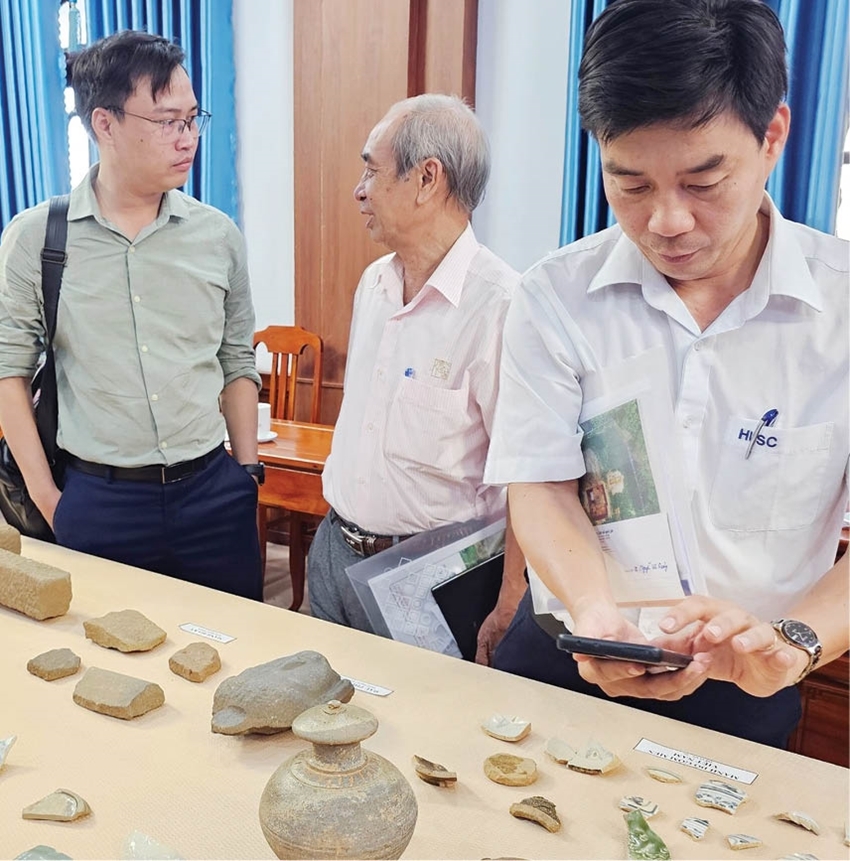 |
| After the 2-month archaeological excavation, the Provincial People's Committee agreed to expand the archaeological excavation area for Lieu Coc Twin Towers |
Lieu Coc Twin Towers monument located in Bau Thap Village, Huong Xuan Ward (Huong Tra Town) is seen as an architectural and artistic monument with many values, marking a period of development in the history and culture of the Vietnamese in general and the Chams in particular. This monument was ranked as a National Architectural-Artistic Monument.
Typical religious architecture
Lieu Coc Twin Towers lie on the right bank of the Bo River on a small natural slope, consisting of two towers built close together on two parallel axes in the East-West direction.
In the List of Monument Résumé submitted for recognition as National Monuments, Thua Thien Hue Museum (currently Thua Thien Hue Museum of History) judged that the Lieu Coc twin towers are a religious architectural work typical of the Champa people... This is a valuable monument in terms of science, history, and architecture.
It marks a period, a stage of development of the history and culture of the Vietnamese in general and of the Chams in particular in the process of creating traditions, on the basis of acquiring the cultural values in the artistic architecture of the regional countries with an eye to creating the characteristics of their nation. This monument also clearly reflects the inheritance combined with innovation in the architectural and construction techniques of the Chams in the 9th - 10th centuries in the province.
 |
| Many artifacts were found during the archaeological excavation from last April to June at the Lieu Coc Twin Towers monument |
Therefore, the archaeological research and excavation to clearly determine the scale, structure, nature, and date of the monument is sorely needed. The results achieved will practically and effectively serve the planning, conservation, restoration, and promotion of the overall value of the monument. The archaeological excavation, which took place in late April and lasted for 2 months, was considered quite surprising when thousands of relics were discovered and a system of stratigraphic structures with many layers was revealed.
Mr. Nguyen Ngoc Chat, Deputy Head of the Research and Collection Department, National Museum of History - Head of the archaeological excavation team of Lieu Coc Twin Towers monument said that before constructing the towers, the ancients added an amount of alluvial soil to create a level surface, then compacted it with a 5-12cm-thick layer of laterite soil and brick powder to reinforce the bottom of the tower foundation.
According to Mr. Chat, after the three excavation pits were merged, the entire scale, ground, foundation structure, tower base, and the rest of the North Tower body were unearthed. Along with the scale of the North Tower's architectural foundation and other related architectural traces unearthed, a number of relics including 4,807 specimens were also obtained during the excavation. They include largely architectural materials, architectural decorations, stelae and stone reliefs, glazed ceramics, porcelain, earthenware, and coins.
Agreement to expand the archaeological excavation area
From those findings, head of the excavation team commented that the Lieu Coc Twin Towers are a rare Champa tower temple monument still visible on the ground from North My Son outward. More luckily, it lies on Thua Thien Hue land, where there are Phu Dien Tower and traces of dozens of other Champa ramparts and temples, contributing vividly to the panorama of Hue's cultural depth.
The results of exploration and excavation clarified part of the overall architectural plan of Lieu Coc Tower Temple with architectural features, sculptural art, inscriptions, etc. clearly showing that this is a religious architectural work of the Champa people. The construction of the North Lieu Coc Tower is temporarily dated to the late 9th century.
“Further, when comparing the decorations on the walls of the North Tower and the South Tower in Lieu Coc, we also noticed a difference in the decoration of the columns and wall pillars of these two towers. Most likely, the two towers do not have the same construction date. This requires the continued supplementation of documents when there are conditions for researching and expanding the excavation area," Mr. Chat commented.
Meanwhile, Mr. Phan Thanh Hai, Director of the Department of Culture and Sports, set great store by the archaeological results of Lieu Coc monument and agreed on the monument excavation expansion before the rainy season. Therefore, the Department sent a report to the Provincial People's Committee in late June, and right in early July, the Provincial People's Committee also agreed on the policy of expanding the archaeological excavation area of Lieu Coc Twin Towers monument.
The province also assigned the Department of Culture and Sports to carry out the procedures to request permission from the Ministry of Culture, Sports and Tourism to ensure compliance with the regulations. In addition, the province requested the People's Committee of Huong Tra Town to research and develop a sustainable plan for monument protection with an eye to preserving and promoting the value of Lieu Coc Twin Towers monument for tourism exploitation and economic development.